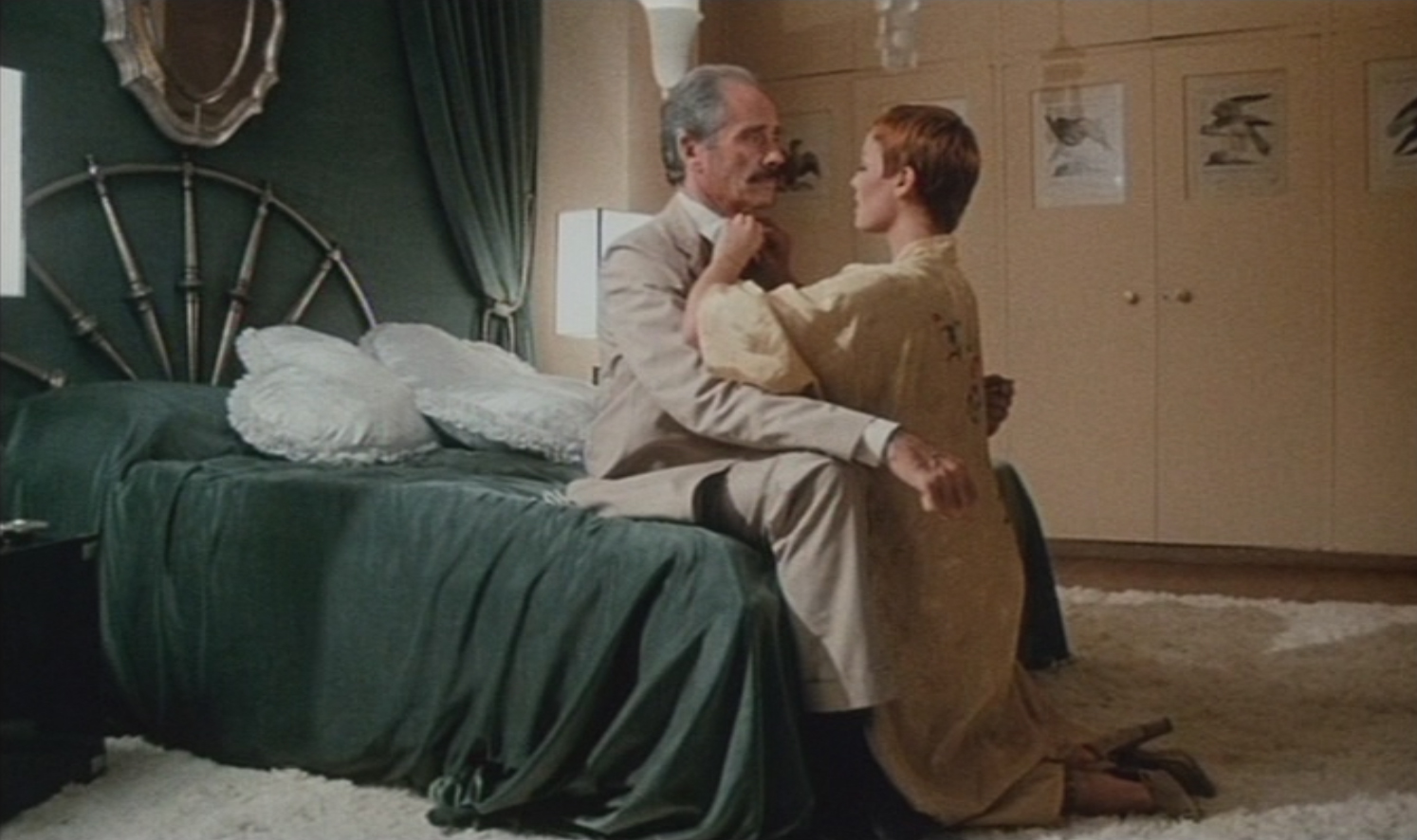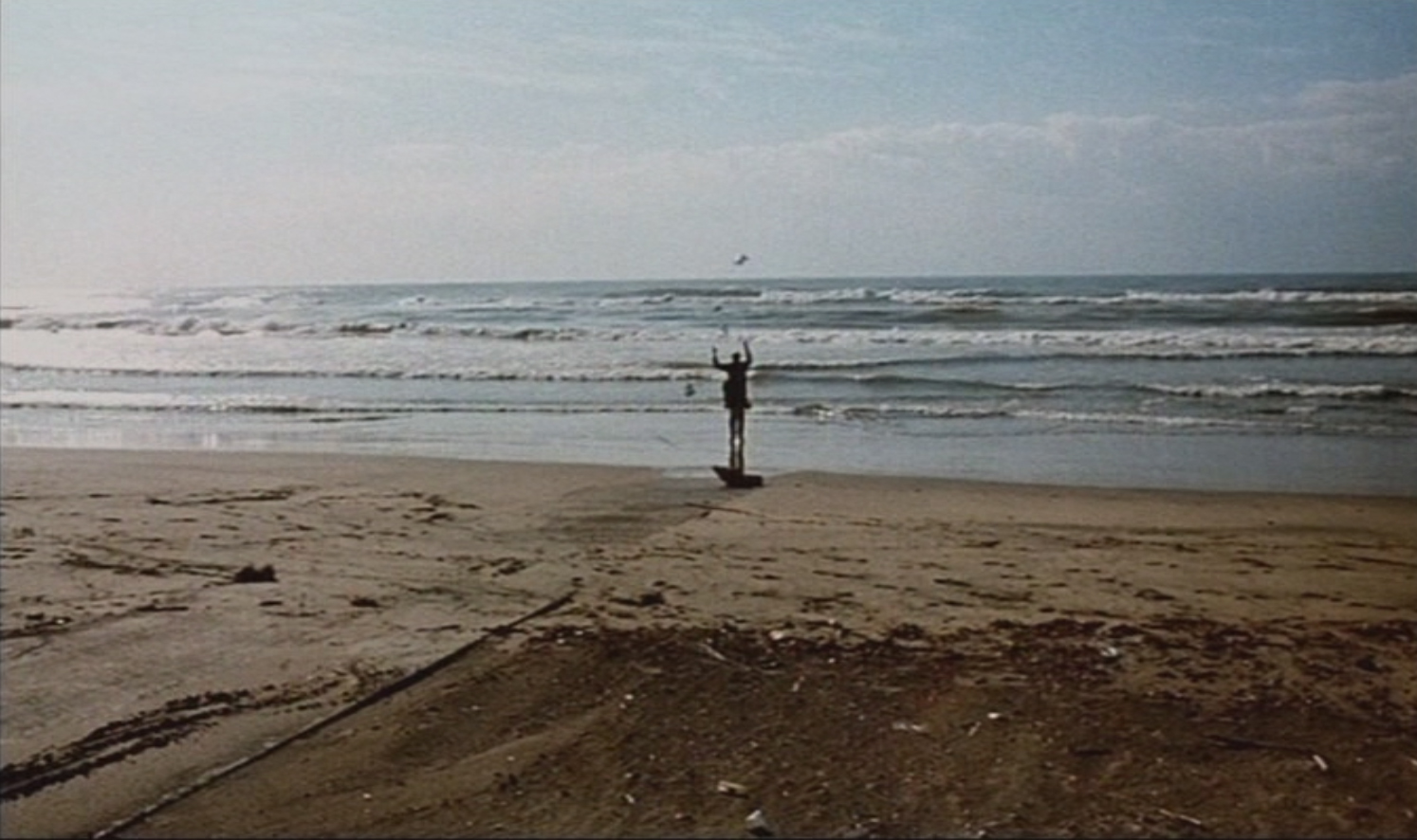

[This is the twenty-eighth post in a continuing series discussing and analyzing all the Krimis and Gialli I've seen. AS WITH ALL POSTS ON THE SITE, SPOILERS SHOULD BE EXPECTED FOR EVERY FILM DISCUSSED.]
My Giallo Rating: ★★★★½ (out of 5)
Subcategory (if any):
i. Meta-Giallo (aka, Experimental Giallo)
ii. Sleaze-Art-Sleaze Giallo (aka, Exploitation Giallo)
iii. Country Giallo
iv. Psychosexual Outlier Giallo
In My Giallo Top 50 (Y/N): Yes
Equal parts INVESTIGATION OF A CITIZEN ABOVE SUSPICION, WHAT HAVE YOU DONE TO SOLANGE?, and DON'T TORTURE A DUCKLING (even WHO SAW HER DIE?), Manfred Purzer's DAS NETZ (THE NET; 1975) is one of the most unexpected (and unexpectedly satisfying) Gialli I've discovered since I started my quest a few years back to track down every Giallo ever made. And this a discovery totally by accident—I stumbled across the title while searching Amazon Germany for a Eurocrime starring Horst Frank (FLUCHTWEG ST. PAULI). In the "related films" tab there it was, with an illustration of Klaus Kinski's weirdly rendered face dominating the DVD cover. I checked if the disc was English-friendly (it has a dub, though sadly no subtitles for the German track), checked the rest of the cast (which included Mel Ferrer, Elke Sommer, Carlo De Mejo, and POSSESSION's Heinz Bennent), and decided to take a chance.
I assumed, from the summary I found over at Letterboxd, that it would be a fairly staid police procedural covering the murder of a prostitute. Instead what I found once it arrived (the package twice delayed by customs) was an Experimental Giallo that used a sophisticated flashback structure and a meta-approach to tell the story of a low-key, gray-haired, atypical serial killer (a fiction writer whose work overwrites his "real" life, as he begins to kill those whose morals he feels are atrophying society's appetite for his books). He kills a prostitute in Rome—goes into flashback to show the murder of schoolgirls in the countryside—all the while being paid to write a salacious, Giallo-like memoir detailing his killing spree. It's really something. And a film that, if you're willing to get on its wavelength (less Dario Argento, more Elio Petri), is extremely rewarding as an *nth* example of just how many different forms the Giallo genre can contain
[SITUATING IT IN THE GENRE]
And make no mistake, it is a Giallo. While watching it, I kept thinking of something I'd read in Maitland McDonagh's study of Argento, during her discussion of the influence of certain strains of detective fiction on films like TENEBRAE and OPERA. She cites Cornell Woolrich, Dashiell Hammett, Pierre Boileau, Thomas Narcejac, and Robert Aldrich's take on Mickey Spillane (who just seems to keep popping up here of late):
"A more apposite model of detection may be found in Robert Aldrich's film of Mickey Spillane's KISS ME DEADLY (Spillane is, significantly, also invoked in TENEBRAE). 'You find a little thread,' coos Aldrich's Velda to a singularly stupid and unimaginative Mike Hammer, 'and it leads to a string. You follow the string till you find a rope, and from the rope you hang by the neck until ...' Until indeed ... what following the thread, the string and the rope doesn't do is lead to a solution, a way of righting the wrong that has disrupted the flow of an otherwise orderly universe, because no such solution is possible. This is the network of ideas informing Argento's films ..."A world of detection where true solutions—solutions that restore order, intelligibility, safety—aren't possible. Solutions that uphold nothing but how permanently unsettled—unsane (to borrow one of the many translated titles tacked onto TENEBRAE)—this cinematic world is. Its natural state: an unfixable, traumatic state that overwrites the lives of all its inhabitants, no matter whether they live or die. (And, not coincidentally, it's the same conclusion that David Sanjek comes to re: the permanently cracked worldview of the Giallo.)
Think the last, apocalyptic shot of KISS ME DEADLY, with an irradiated, gun-shot Mike Hammer stumbling into the drink, only able to stand because of Velda, both of them watching the end of the world (a dirty bomb detonating inside the beach house) happen before their eyes. Think Marc Daly staring into the abyss of the killer's blood at the end of DEEP RED, that blood transferring the hidden trauma of Carlo's life to his. Think Ingrid Thulin at the end of Lado's SHORT NIGHT OF GLASS DOLLS, shrieking into the camera as she watches her still-alive lover, Jean Sorel, get vivisected before her eyes (with the camera freezing as "THE END" gets thrown up over her desolated face). Or Daria Nicolodi, at the end of TENEBRAE, one-upping and perfecting that shot, that state.
This is the worldview of the Giallo, whether or not there's a black-gloved killer in sight, and it is most assuredly the worldview of DAS NETZ. (And there are other Giallo-isms, including a number of the criteria I'm using to build my Giallo Master List; the Intro Page lists them.)


One of the things that I've argued "meta" or "experimental" Gialli tend to do is to invoke Giallo conventions—the devices those familiar with the genre have been conditioned to expect—only to subvert the expectations associated with them. Teasing the visceral, visual, stylistic allure of these conventions, only to withold or undercut their expected payoff. I.e., taking the conventions and doing "anti" examples of them.
Think of the way that an Experimental Giallo like Petri's INVESTIGATION opens with an elaborately staged murder set-piece—Volonté ritually murdering Bolkan's character, fleeing down a spiral staircase, all to the strains of idiosyncratic Morricone music—that sets up a Giallo expectation in the audience. I.e., that there will likely be more elaborately staged, ritually dressed murders in this thriller-mystery story.
But of course there aren't. Instead, Petri seems to fill the spaces where we would expect more murders with flashbacks that leak in and out of the film's "current action" (in ways that often don't make it clear what is and isn't flashback, a point that Lee Howard brought up in the Movie Matters podcast covering Petri's film). We get flashbacks of Volonté and Bolkan re-enacting other famous "sex crimes" (which we gradually learn was their version of foreplay), as well as reveries involving Volonté's character that play like weird sadomasochistic wish-fulfillments, scenes where he is happy—almost relieved—to submit to The Law whose punishment he's been teasing throughout the film (the end of the movie is perhaps the most potent example of this).
Likewise, DAS NETZ plays with the audience's awareness and expectation of such scenes. Each murder set-piece is staged in a familiar way, with the Giallo killer (Ferrer, committing the murders for confused sex- and mother-related reasons from his past) making contact with a physically attractive woman who will become his victim. The scenes often involve that woman disrobing, quite casually (even gratuitously), as Ferrer obliquely hints at his true reason for their meeting. And the *aftermath* of each scene shows the discovery of the murdered victim, usually still nude, in recognizable exploitation style; usually with some sort of vicious method employed to murder her (I'm thinking esp. of the phone cord strangulation of the lolling nude prostitute at the start).
But:
In all but one instance, Purzer withholds the actual murders from us. We do not see, onscreen, the elaborately staged act—the outre use of the weapon, breathless exertion, the onscreen gore—only its buildup and aftermath. Effectively this makes the set-pieces feel "off" somehow, as though they're missing the key information and images that would quality them as a Giallo set-piece in the first place. Purzer seems to know that we, as audience, have been conditioned to expect such visual information—Argento's dizzyingly executed DEEP RED was released the same year after all—and yet is intent on withholding it.
This achieves a couple of things: It shifts the focus of the film from "exploitation" to "experimental". It also invites us, through its conspicuous absences, to imagine this missing violence. Just as Ferrer is contracted to describe the sordid details of his crimes in his murder memoirs, we are invited to re-create those same details in our own minds. Drawing on a whole genre's worth of templates and examples to do so.
Further, it places an even greater emphasis on character—on developing, understanding, empathizing with the key cast members. Instead of watching an extended scene of a sputtering, heaving, flailing nude woman being brutally strangled with a phone cord ripped out of the wall, we spend time watching the complicated expressions flit across Ferrer's remembering face; the smirking, twitching, always cigarette-smoking rock'n'roll imp that is Kinski's scheming reporter; or the strange distances Susanne Uhlen seems to be searching out in her face.


There is an absolute embarrassment of riches when it comes to the film's cast. Not only remarkable names, but remarkable performances almost across the board:
 |
| Kinski! |
 |
| Kinski! |
 |
| Kinski! |


Her profound interest in his work as a writer—as well as a moment when she invites him to read her interest in him as also an amorous one—brings Ferrer momentarily back from his self-destructive brink, from his acquiesence to the market forces that have convinced him the only way to make money as an author is to kill people and then write about it. Her various appearances in the story feel at times like something out of a Gothic fairy tale. Each time she appears, she's wearing a distinctive, different "character costume"—mousy country local; alluring tennis player; gauzily lit high-society debutante; ghost of the Gothic past. This shifting persona (as coded by the at-time inexplicable costume changes) helps to suggest that she may somehow exist outside of the reality of the rest of the characters, outside of time (the scene in the castle esp. feels like it is a timeless restaging of a past Gothic encounter), or even as a kind of idealized version of all the women Ferrer's character has encountered (and killed) up till then.
[AND THEN THERE ARE THE TIMES WHEN PURZER'S STYLE *DOES* INTRUDE]
Just because it's an "anti" or "experimental" Giallo doesn't mean it lacks flash and style altogether. Or that the unusual weight it places on character development keeps it from showing off. After Kinski intuits (and makes contact with) the film's killer, he races to go see his magazine editor and finalize a contract for the killer to write his memoirs. Here the movie becomes suddenly frenetic, geometric, with Kinski's miniature body racing through oversized enviroments that reminded me most of Storaro's geometric compositions in THE FIFTH CORD:

Earlier on, we'd gotten examples of Ferrer funneled through various forms of media, mostly photographs:
 |
| Notice how the double-circle of the sight finder in the camera mimics the hand-drawn circles singling him out in the crowd in the first photograph. |
Ferrer flings his last manuscript pages into the air before wading out into the water. Once in the water—he seems disoriented, overwhelmed by the crashing waves—we get clipped glimpses of him pulling a gun and shooting himself in the head. Then more rushing waves. And a cut back to the film being projected in police headquarters. In effect, we are getting yet another version of story, a tiny bit of this tourist's "memoir," that serves as the end of Ferrer's own work (not to mention the film's):


Leonard Jacobs
April, 2015
[SHOW NOTES]
VERSION WATCHED: German DVD | LANGUAGE: English dub; the disc includes a German soundtrack, but no English subtitles | DIRECTOR: Manfred Purzer | WRITER(S): Hans Habe, Manfred Purzer | MUSIC: Klaus Doldinger | CINEMATOGRAPHER: Charly Steinberger | CAST: Mel Ferrer (Aurelio Morelli); Klaus Kinski (Emilio Bossi); Heinz Bennent (Inspektor Canonica); Susanne Uhlen (Agnese); Elke Sommer (Christa Sonntag); Andrea Rau (Herta Enzian); Carlo De Mejo (Francesco Vanetti); Claudio Gora (Carlo Vanetti); Sabine von Maydell (Bibliothekarin); Franz Rudnick (Canonicas Assistent)











































No comments:
Post a Comment